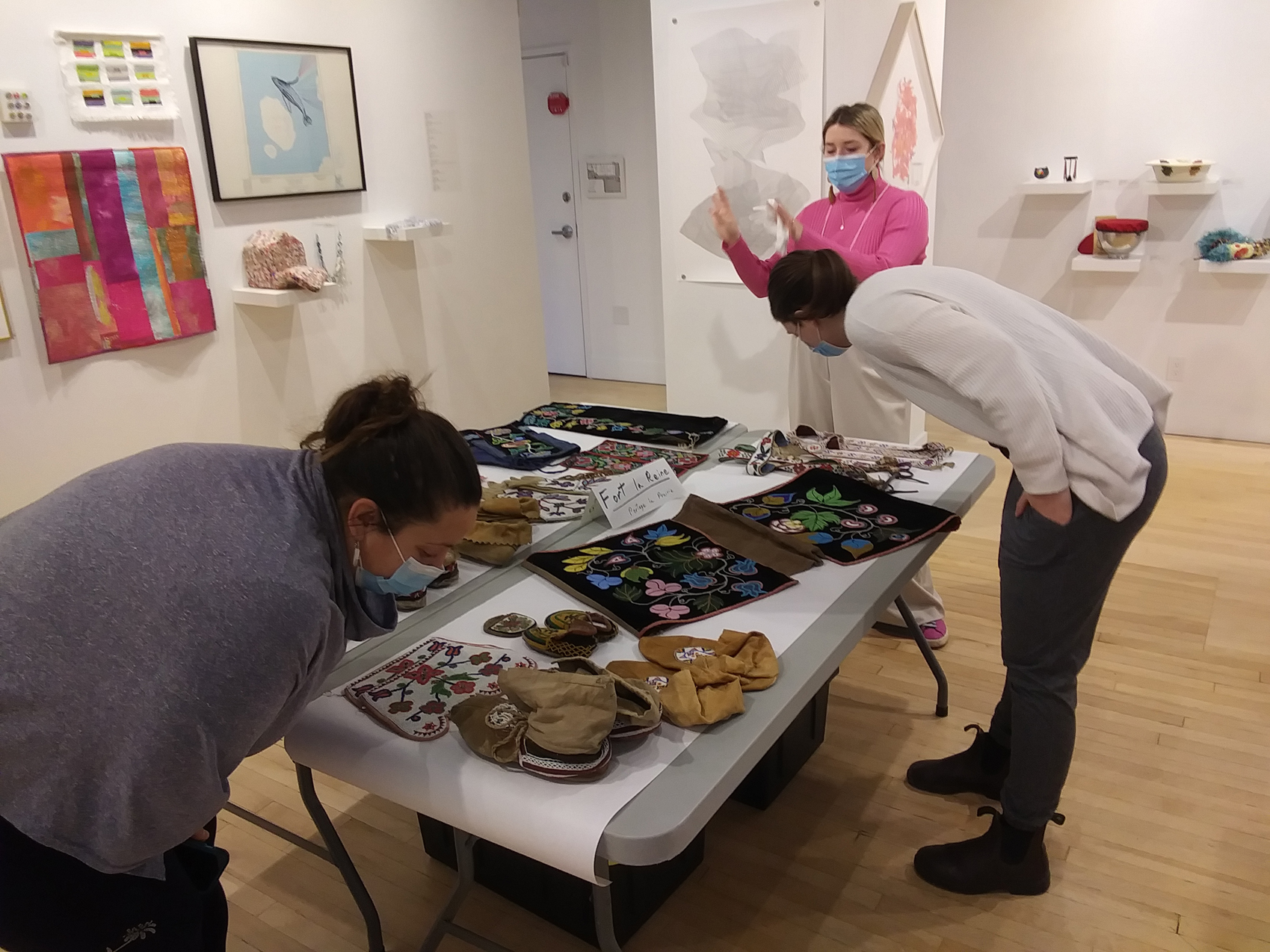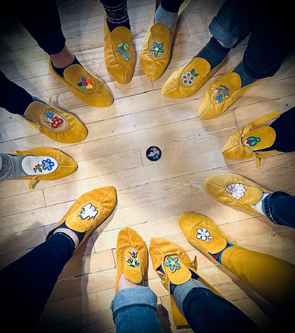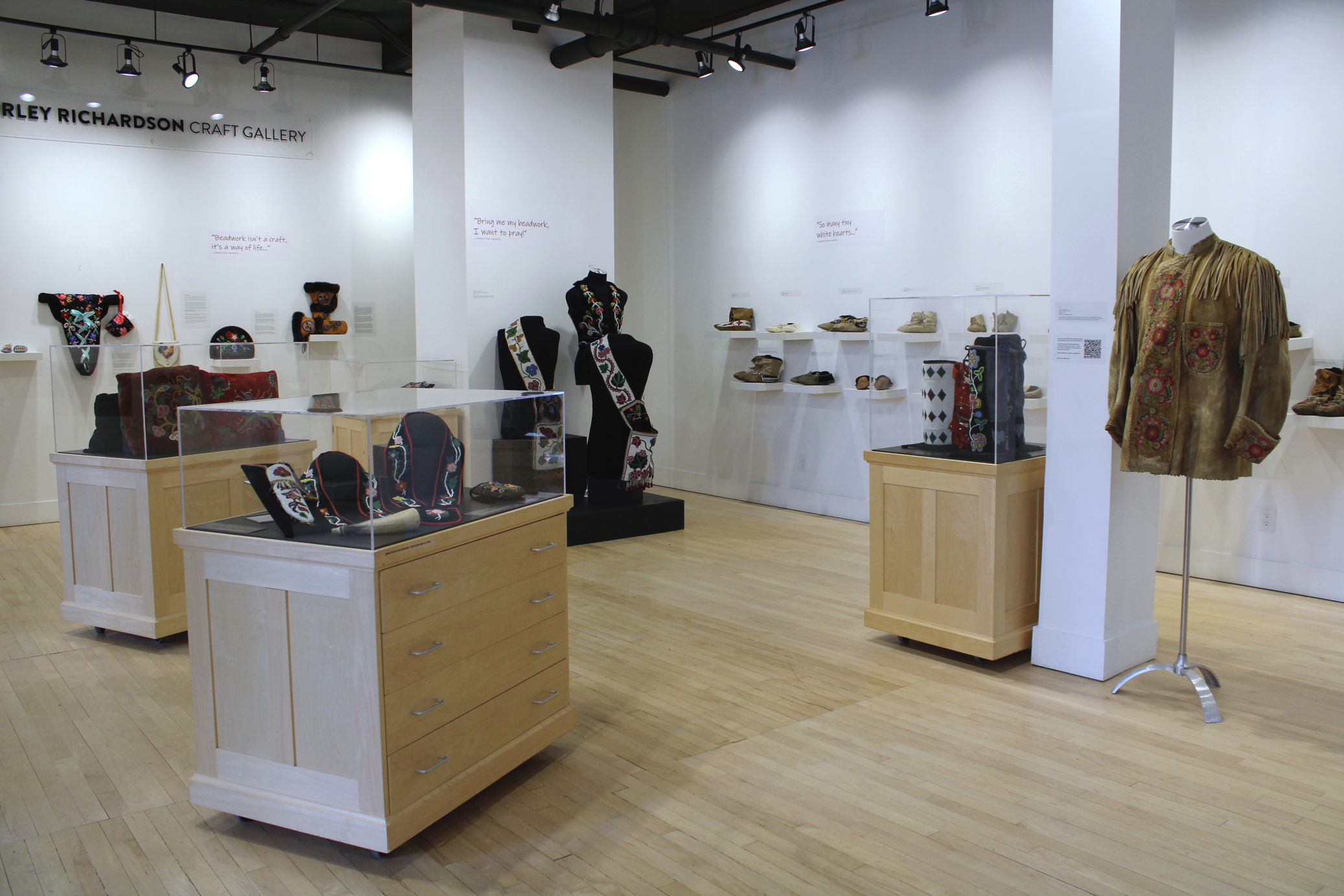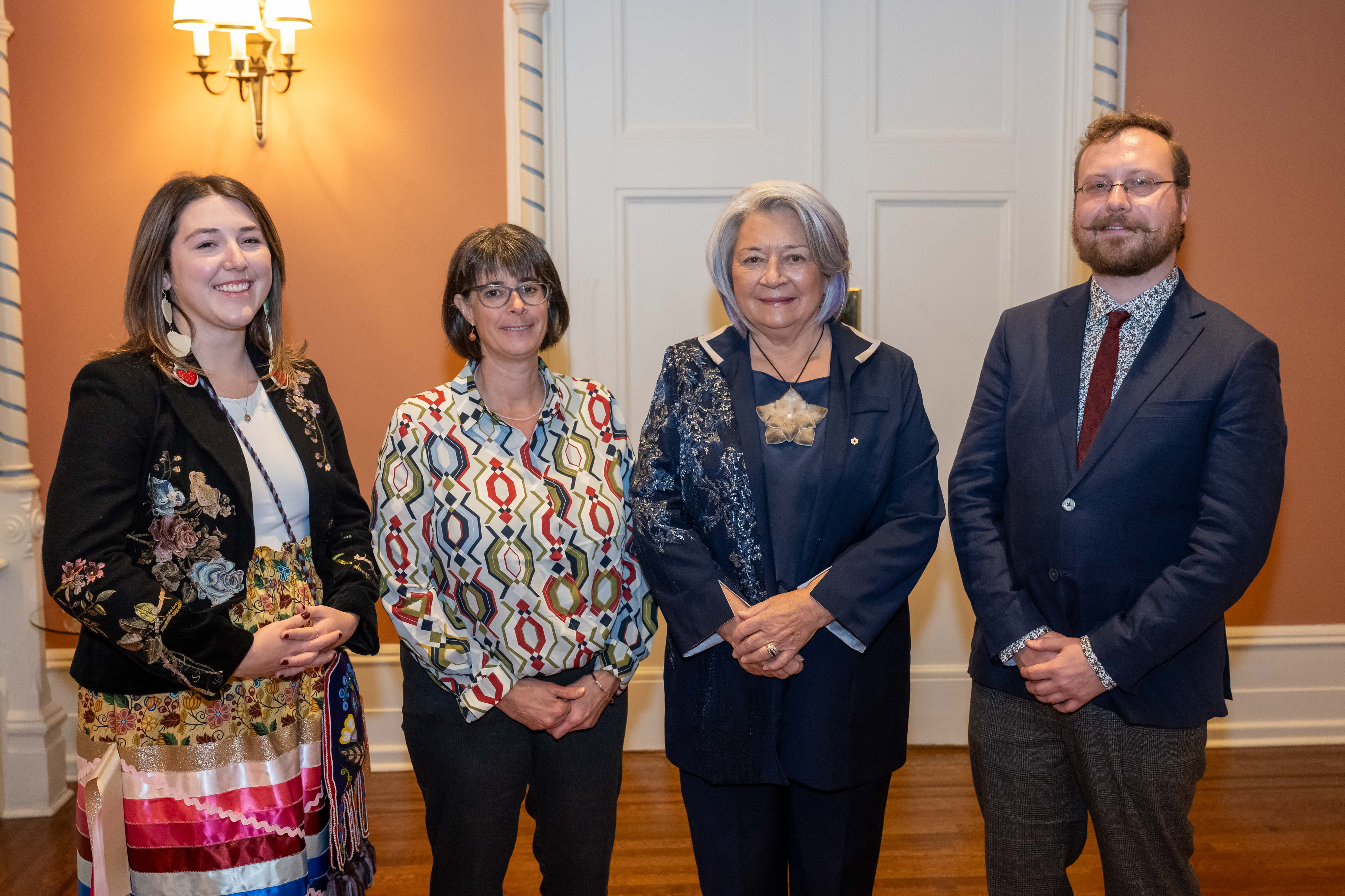mámawihitowin | Ganaagishkwadaadiwin | Asenbli | Rencontre | Gathering: Indigenous Beadwork, Embroidery and Quillwork
Peter Simpson

Margaret Firlotte, project coordinator, hosts community members in a closed and informal viewing session.
Inspiring lessons can be learned from seeing the exhibition Gathering: Indigenous Beadwork, Embroidery and Quillwork, this year’s winner of the Governor General’s Award for Excellence in Museums: History Alive!
The first lesson in the Winnipeg-based exhibition organized by the Manitoba Crafts Museum and Library and Ross House is that Indigenous beadwork is both vital history and a vibrant contemporary craft.
The second lesson is that when small museums come together, they can make incredible steps in both research and inclusion. That inclusiveness started with the title and translations of the keyword “Gathering” in Mámawihitowin (Ininimowin — Cree), Ganaagishkwadaadiwin (Anishinaabemowin — Ojibway), Asenbli (Michif), and Rencontre (French).

Moccasins made at one of the project’s affiliated workshops with artist Cynthia Boehm.
The project was envisaged by Andrea Reichert, Curator for Manitoba Crafts Museum and Library (MCML), and Eric Napier Strong, Curator for Ross House Museum, and was carried out with the support of Margaret Firlotte and other museum staff. Additionally, items from collections came from all over Manitoba.
“Small museums often just see their limitations, and I always try to talk to people about recognizing that those can also be opportunities,” says Napier Strong. “Because we're small, we can be flexible, and we can do things in the way that we want to do them. If we say, hey, we want to do this project . . .”
Each of the 11 museums that played a role in the exhibition was like a bead in an intricate design. The other museums — most of them relatively small community collections — included Fort Dauphin Museum, Fort La Reine Museum, Hillcrest Museum, Le Musée de St. Boniface, Manitoba Museum, Sam Waller Museum, Seven Oaks House Museum, Transcona Museum, and the Winnipegosis Museum and Historical Society.
The project also included work by contemporary Indigenous artists Bronwyn Butterfield, Meaghen Fillion, David Heinrichs, Tashina Houle-Schlup and Shauna Ponask. Many more Indigenous artists, community members and elders participated formally or informally in the project, and, of course, many Indigenous artists made the 100 or so pre-1900 works that were included. The curators wanted to emphasize that beading is a continuing tradition, and that contemporary artists are informed by that tradition and are using it to in new ways to create new works.

Gathering exhibit in the C2 Centre for Craft exhibition space, located in Winnipeg, MB.
The project included the exhibition, held at the C2 Centre for Craft in Winnipeg in the spring of 2023, and a permanent online database of more than 100 items that were collected, researched and included in the final exhibition. The exhibit was one of the most successful in the MCML’s history, with an enthusiastic public response both to the physical exhibit and to the online resources that rewarded the ambition and vision of the team.
A news release from Canada’s History Society and the CMA hailed the project as “an ambitious initiative to uncover, research, exhibit, and celebrate pre-1900 Indigenous beadwork, embroidery, and quillwork objects held by museums throughout the province of Manitoba,” and for “transcending traditional museum practices and fostering community, inclusion, and reconciliation.”
Reichert and Napier Strong have often talked about helping smaller museums to manage their collections, as they knew that many Manitoba museums have Indigenous work in their collections, but were not be able to say whether the works are from an Anishinaabe artist, a Cree artist, or a Métis artist. In late 2021, the Manitoba government launched a Community Museums Project grant, which funded projects related to collections management and to those with an emphasis on reconciliation and inclusion.

Moose hide jacket with Norway House style silk floral embroidery by an unknown Ininiwak artist, c.1910-1920. From the collection of the Manitoba Crafts Museum and Library.
“This new funding stream came out of the blue,” Reichert said, “and I thought, I'm going to talk to Eric and see if he wants to put together a project related to Indigenous beadwork, quillwork and embroidery, some sort of research project that culminates in an exhibit. And he jumped on it.”
The history was long, but the timeline was short. Only 10 months remained by the time Margaret Firlotte was brought on as Project Co-ordinator by the Manitoba Crafts Museum and Library. Firlotte, who is Métis and also a beadwork artist, began by reaching out to many museums and communities around the province, and then six months remained for the team to properly research and honour the pieces.

Award recipients Margaret Firlotte, Andrea Reichert and Eric Napier Strong pose with Her Excellency the Right Honourable Mary Simon following the formal awards presentation.
Despite the hurried timeline, the exhibition was also able to provide access to the featured objects to more than 70 Indigenous community members, including Elders, historians and artists to learn from, connect with and provide additional context for the temporarily assembled collection. This was done through uncurated and informal sessions with the works simply laid out on tables.

Beaded Dog Blanket, or “Tuppie”, worked by an unknown Métis artist of the Red River Diaspora, c. 1875-1890. It was originally owned by the Inkster family of the Seven Oaks House Musuem. From the collection of the Manitoba Museum.
In combining this diaspora of Indigenous and Métis beadwork, those who might benefit from it most were able to access it more easily, extending the team’s work from ambitious exhibition into a supportive community-based initiative.
The public interest in exhibition and database, and the Governor-General’s Award, gives the team hope that funding can be acquired to expand the project.
“We’re hoping for a second phase, even if it’s a similar timeline,” Firlottle says, “because people have seen that we’ve done it before and they’ll be more interested and more eager to participate. We had other museums in Manitoba reach out and express their interest in participating.”
Peter Simpson lives in Ottawa and has been writing about Canada’s museums and galleries for more than 20 years.
The Governor General’s History Award for Excellence in Museums is facilitated by the CMA with support from our partner, Canada’s History and the generous support of our sponsor Ecclesiastical Insurance.

“Ecclesiastical Insurance is once again proud to support the Governor General’s History Award for Excellence in Museums, as its purpose aligns with our commitment to preserve and protect Canada’s unique history and cultures. Congratulations to the Manitoba Crafts Museum and Library, and Ross House Museum on your collaborative work to showcase and celebrate Indigenous beadwork, embroidery, and quillwork. This award celebrates Indigenous resiliency and builds awareness of the beauty and power of this artform.”
- David Huebel, President of Ecclesiastical Insurance
